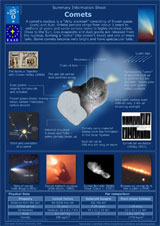|
Though frequently beautiful, comets traditionally have stricken terror as often as they have generated wonder as they arc across the sky during their passages around the Sun. Astrologers interpreted the sudden appearances of the glowing visitors as ill omens presaging famine, flood or the death of kings. Even as recently as the 1910 appearance of Halley's Comet, entrepreneurs did a brisk business selling gas masks to people who feared Earth's passage through the comet's tail. In the 4th century B.C., the Greek philosopher Aristotle concluded that comets were some kind of emission from Earth that rose into the sky. The heavens, he maintained, were perfect and orderly; a phenomenon as unexpected and erratic as a comet surely could not be part of the celestial vault. In 1577, Danish astronomer Tycho Brahe carefully examined the positions of a comet and the Moon against the stars during the evening and predawn morning. Due to parallax, a close object will appear to change its position against the stars more than a distant object will -- the same effect that you see if you hold up a finger and look at it while closing one eye and then the other. The Moon appeared to move more against the stars from evening to morning than the comet did, leading Tycho to conclude that the comet was at least six times farther away. A hundred years later, the English physicist Isaac Newton established that a comet appearing in 1680 followed a nearly parabolic orbit. The English astronomer Edmond Halley used Newton's method to study the orbits of two dozen documented cometary visits. The orbits of three comets seen in 1531, 1607 and 1682 were so similar that he concluded they in fact were appearances of a single comet wheeling around the Sun in a closed ellipse every 75 years or so. He successfully predicted the next visit in 1758-9, and the comet thereafter bore his name. Since then, astronomers have concluded that some comets return relatively frequently, in intervals ranging from 3 to 200 years; these are called "short-period" comets. Others have enormous orbits that bring them back only once in hundreds of millennia. In the mid-1800s, scientists also began to turn their attention to the question of comets' composition. Astronomers noted that several major meteor showers took place when Earth passed through the known orbits of comets, leading them to conclude that the objects are clumps of dust or sand. By the early 20th century, astronomers studied comets using the technique of spectroscopy, breaking down the color spectrum of light given off by an object to reveal the chemical makeup of the object. They concluded that comets also emitted gases as well as molecular ions. In 1950, the American astronomer Fred L. Whipple (1906-2004) authored a major paper proposing what became known as the "dirty snowball" model of the cometary nucleus. This model, which has since been widely adopted, pictures the nucleus as a mixture of dark organic material, rocky grains and water ice. ("Organic" means that the compound is based on carbon and hydrogen, but is not necessarily biological in origin.) Most nuclei of comets range in size from about 1 to 10 kilometers (1/2 to 6 miles) in diameter. If comets contain icy material, they must originate somewhere much colder than the relatively warm inner solar system. In 1950, the Dutch astronomer Jan Hendrick Oort (1900-1992) used indirect reasoning from observations to predict the existence of a vast cloud of comets orbiting many billions of miles from the Sun - perhaps 50,000 astronomical units (AU) away (one AU is the distance from Earth to the Sun), or nearly halfway to the next nearest star. This region has since become known as the Oort Cloud. A year later, the Dutch-born American astronomer Gerard Kuiper (1905-1973) pointed out that the Oort Cloud is too distant to act as the nursery for short-period comets. He suggested the existence of a belt of dormant comets lying just outside the orbits of the planets at perhaps 30 to 100 AU from the Sun; this has become known as the Kuiper Belt. (Other astronomers such as Frederick Leonard and Kenneth Edgeworth also speculated about the existence of such a belt in the 1930s and 1940s, and so the region is sometimes referred to as the Edgeworth-Kuiper Belt, the Leonard-Edgeworth-Kuiper Belt, and so on.) Close encounters with other dormant comets sometimes change their orbits so that they venture in toward the Sun and fall under the influence of the gravities of the giant outer planets -- first Neptune, then Uranus, then Saturn and finally Jupiter. The Oort Cloud, by contrast, would be the home of long-period comets. They are periodically nudged from their orbits by any one of several influences - perhaps the gravitational pull of a passing star or giant molecular cloud, or tidal forces of the Milky Way Galaxy. In addition to the length of time between their visits, another feature distinguishes short- and long-period comets. The orbits of short-period comets are all fairly close to the ecliptic plane, the plane in which Earth and most other planets orbit the Sun. Long-period comets, by contrast, dive inwards toward the Sun from virtually any part of the sky. This suggests that the Kuiper Belt is a relatively flat belt, whereas the Oort Cloud is a three-dimensional sphere surrounding the solar system. Read more about why comets are important targets of study. This text is extracted from the NASA Deep Impact Launch Press Kit. More information on the Deep Impact mission is available on the project home page. |
|
For more historical background on comets, please have a look at the History of Comet page.

